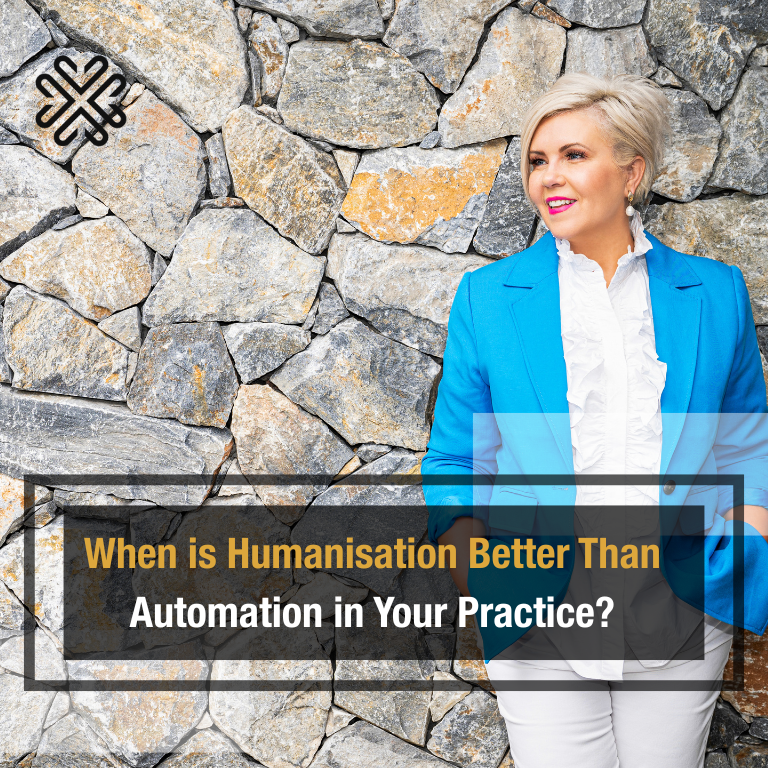When Is Humanisation Better Than Automation in Your Practice?
Fiona, a coaching client, came to work with me at an interesting time in her practice. She had built a thriving practice entirely on her own, and was incredibly busy. Her calendar was full – every minute of the day packed with coaching sessions.
Being so busy wasn’t working out well. Fiona was working nights and weekends, and all the hours of the day, and she was close to burn out. Yet she wasn’t growing her revenue.
Fiona was struggling. She was exhausted and unfocussed.
When we came to work together one of the first things I noticed was her calendar. She was using a scheduling link to let people book themselves in. This automation was efficient and took the task off her own shoulders, which was good for her as a one-woman show.
But while it looked efficient, it actually made Fiona feel like she was in a pinball machine – being bounced from one task to the next with no control, and no time to breathe in between. And all her slots were being taken up by coaching clients, leaving her no time for growth activity such as sales calls that would help her grow.
So even though the scheduling link looked efficient, she was left accommodating everyone, saying yes to everything, and burning out. And she was confusing this with being customer centric.
Does this sound familiar?
The Automation Trap
Like in Fiona's case, automation can help streamline your business. And when you’re in the beginning stages of your practice, and truly on your own, then they’re essential. Tools like booking links of course, but also your CRMs, automatic email responses and AI-content can help you save time so you can do the work you’re being paid to do without the expense of hiring a team.
Automation in your business does make things fast and easy for your customer. But at a certain point – and Fiona had reached this point – automation can stop being supportive (at least on its own). The tipping point is different for everyone. But it usually happens when the systems you’ve put in place start feeling like they’re running you, rather than the other way around.
And it's not that anything is wrong, it's just that it's serviced its purpose and now it time to change to a more sustainable approach.
Adopting Humanisation
For Fiona, we needed to make one main change in her practice. She needed to reintroduce the human touchpoint. She an Executive Assistant .
Humanisation of your practice might seem counterintuitive. An EA will cost more than a scheduling tool. And they won’t be quite as fast or responsive. But a good EA that responds promptly and professionally (so still delivers speed and ease for the client) actually creates a much better customer experience. That’s because they provide something that automation can’t – empathy, care and connection.
A study from the Journal of Service Research found that human interaction in service significantly increased customer trust and the value they believed they were receiving. Another study published in the Harvard Business Review found that customers who felt emotionally connected to a brand spent twice as much money with that brand as other customers.
In other words, humanising your practice builds more trust with your clients, helping them see the value you provide and becoming a loyal and long-term client. And those are some of the most important keys to growing.
Finding the Balance — Humanisation versus Automation in Your Business
In a well-intentioned effort to be customer-centric, Fiona felt trapped into saying yes to more than she could comfortably manage. But it’s a misconception that being customer centric means saying yes to everything. If you’re constantly saying yes out of fear of losing a customer, then you risk turning your business into a 24/7 service model where you’re always on (and always exhausted).
The trick is to find the balance between the automation in your business that will help you to be more efficient and the humanisation that will give you the edge to build your practice. That is being customer centric (giving them ease and speed with automation) and being you centric (giving you the space to build your own business).
For Fiona this meant hiring an EA to work with her clients and create space in her calendar for herself (and her sales calls). Of course, for you this may mean something entirely different.
As Jay Baer, author of The Time to Win, says, ‘Give your customers time, and they will give you money.’ This happens with automation. But as John Maxwell, author of The 21 Indispensable Qualities of a Leader says, ‘People don’t care how much you know until they know how much you care.’ And this happens with humanisation.
We need both to successfully build a practice.
Trust the Process
For Fiona, she had to really trust that giving up the automation in her business and scraping back control wouldn’t cost her clients. She had to trust that introducing humanisation would actually serve them better.
It’s not always easy to trust the process. As experts, thought leaders and speakers, we’re usually more comfortable delivering results than creating boundaries. We really want to help. But you can still help – and even help more – when you find the balance in your practice between the client and yourself, and between automation and humanisation.
How to achieve business longevity
So, if you’re feeling like a pinball in your own practice, it might be the right time to reintroduce humanisation in your practice – not just for yourself, but also for your clients.
Ask yourself:
Where in your practice could a real person offer more than an automated person?
Where are you operating out of fear rather than out of strategy?
What boundaries would help you bring out the best in your work?
I’d love to hear your thoughts…


